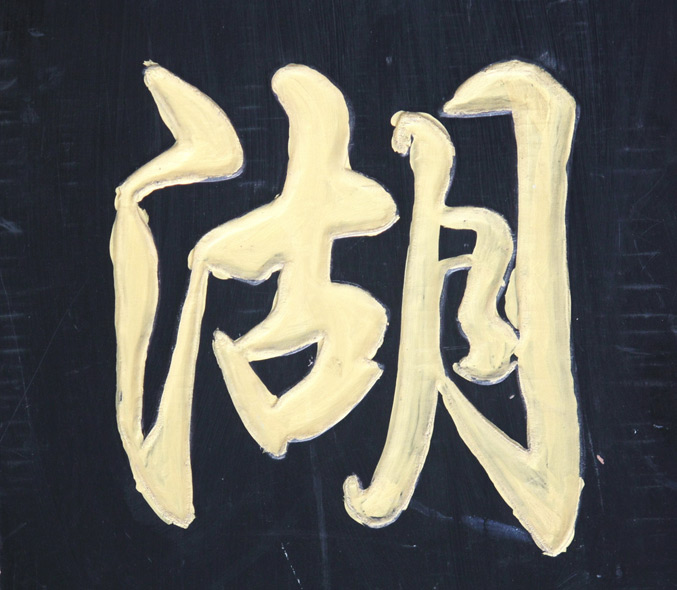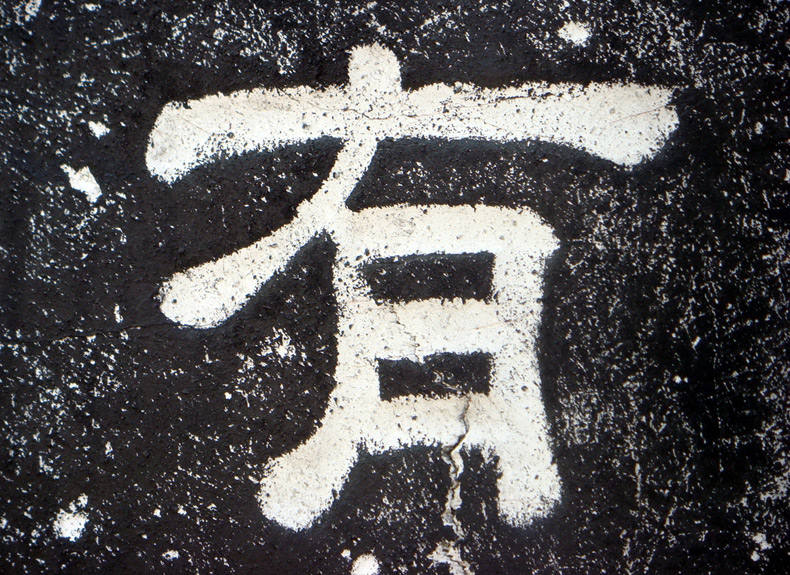130. The "Flesh" Radical: 肉 and 月
Some dictionaries conflate the "flesh" radical and the "moon" radical, filing all characters that have 月 radicals under "flesh." That's because almost anything that once looked like 肉 (flesh) in a kanji now looks like 月 (moon). Aside from the kanji 肉 (365: meat), there's just one Joyo exception: 腐 (1755: to rot), which helps to form 豆腐 (とうふ: tofu).
A much more typical case is 肝 (1096: liver), which used to look like this:

© Richard Sears
Seal-script version of 肝.
If you use your imagination, you can nearly see the resemblance between the part on the left and 肉. The left-hand shape seems much closer to 月, though!
At Joy o' Kanji, we're treating these two radicals as separate entities. In this Radical Note, we'll focus on the pleasures of the flesh—namely, any radical etymologically connected to 肉. If you'd like to know more about the scant Joyo kanji in which 月 means "moon," see Radical Note 74.
A Note on the Yomi
Before we give ourselves over completely to the indulgences of the flesh, let's briefly consider the yomi of the "flesh" radical.
In the two kanji with the 肉 shape (肉 and 腐), we can call that radical にく.
Meanwhile, when referring to all other kanji with the "flesh" radical, we can call that radical にくづき or にく. Two comments about にくづき: First, although it sounds strange, meaning "meat moon," this term is for any radical that represents "flesh" and is written like the character for "moon." Second, にくづき, which includes づ rather than ず, is a great example of the phenomenon discussed in the Thematic Explorations essay on yotsugana!
The "Flesh" Radical on the Bottom of a Kanji
In terms of Joyo kanji representing body parts, here are four in which the "flesh" radical sits on the bottom of the character:
胃 (424: stomach)
背 (957: back)
肩 (1212: shoulder)
Some dictionaries disagree as to whether the radical here is 戸 (the "door" radical) or 月. As you'll see below, dozens of kanji with 月 represent body parts, so I can't see any reason to focus on a door in a kanji meaning "shoulder"! Furthermore, Henshall argues in his newer edition that, most likely, this 戸 was originally a similar-looking character meaning "shoulder and upper arm."
膚 (1757: skin)
This kanji also appears in Radical Note 141 on the "tiger" radical.
The "Flesh" Radical on the Left of a Kanji
Otherwise, 月 is always on the left in Joyo kanji related to body parts. (It would be unsightly if we had flesh only on one side of our bodies, but somehow it works well enough in kanji.) In arranging the following list of kanji for body parts, I tried to work from head to toe, though this sometimes proved difficult!
脳 (954: brain)
腕 (1945: arm; ability)
胴 (1662: torso)
胸 (840: chest)
肺 (958: lung)
肝 (1096: liver), which appeared earlier
腹 (965: belly)
腸 (547: intestines)
腰 (1879: hips; loins; waist; pelvic region)
股 (2004: crotch; thigh; fork (in tree, road, river, etc.))
脚 (1146: leg)
膝 (2100: knee; lap)
A few more represent the surface of the body or things happening beneath the surface:
脈 (589: pulse; vein)
肥 (772: fertile; to get fat)
脂 (1319: fat, grease, blubber)
肌 (1704: skin; surface; texture; disposition)
Inspired by Body Parts
Body parts have inspired a few more characters that contain 月. All etymologies here have come from Henshall:
有 (401: to have)
One tends to overlook the "flesh" in this ultra-common kanji, but it's there. This character originally depicted a "hand" holding a piece of "meat."
能 (766: ability, talent, skill)
This kanji once contained a host of body parts, including claws and a nose! In fact, it represented a "bear"! Some scholars feel that because a bear is such a strong, able creature (Winnie-the-Pooh excluded, I suppose), "ability" came to be an associated meaning.
脅 (1169: to coerce)
Together, the 力 triplets represent "strong arm" and "strength." As 月 is "flesh" or "of the body," 脅 meant "putting great pressure on the body." Then it came to mean "coerce."
脱 (1560: removing (clothes); to escape)
This combination of shapes evolved from "losing flesh" (meaning "losing weight") to "things leaving the body" (such as a child during birth or clothing). "To escape" is an associated meaning.
Neither Flesh nor the Moon
Now that you're thinking of flesh rather than the moon when you see 月, you may be surprised to find that in some kanji, neither one applies. Here are some examples, with etymologies again coming from Henshall:
朝 (175: morning; regime, period, epoch)
Etymologically, that's not a "moon" on the right but a "river." Moon river! Audrey Hepburn's voice just popped into my mind!
育 (227: to be raised)
The shapes of the parts have changed dramatically over time. The bottom component had no original connection to flesh. The whole kanji depicted a woman and a newborn child, and when someone later added 月 ("flesh," in this case), that may have been to represent "birth" or "drops of amniotic fluid."
服 (385: clothes; to submit)
Initially, the part on the left was a "boat"!

In 湖 (276: lake), the 月 is not a radical but rather a component. And according to Henshall, this 月 doesn't mean "moon" or "flesh" but rather "beard"! Who'd have guessed?!

